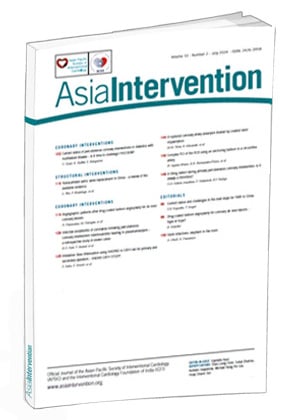Transcatheter aortic valve replacement (TAVR) has been established as standard interventional therapy for symptomatic severe aortic stenosis (AS) regardless of surgical risk owing to multiple pivotal trials along with technological advances and increased procedural experience. This evolution in interventional cardiology has led to huge expansions of TAVR into clinical practice in Western countries123. In Asian countries, although the initial uptake of this intervention lagged behind Western countries, more recently, its adoption has been rapidly and widely spreading4. Nationwide registry data in Japan have demonstrated that the safety and effectiveness of TAVR have been comparable to those in Western countries45. Meanwhile, reports from China have been mainly limited to small studies so far. Considering the population size and the ageing society in China, AS represents an increasing healthcare and socioeconomic burden, warranting a better understanding of the current status of TAVR in China.
In the current issue of AsiaIntervention, Wei et al have reported a systematic review regarding the characteristics and outcomes of TAVR in China6. To our knowledge, this is the first systematic review of literature for TAVR recipients in China. The main findings are the following: (i) in China, although surgical aortic valve replacement remains the most common therapeutic option (~40,000 procedures per year) for severe AS, TAVR has been increasingly performed over recent years (from 293 procedures in 2017 to 7,357 procedures in 2021); (ii) bicuspid morphology is common (up to ~50%) as an aetiology for severe AS in patients undergoing aortic valve replacement in China, posing clinical challenges for TAVR; (iii) four locally manufactured self-expanding transcatheter heart valves (THVs) and the balloon-expandable SAPIEN 3 THV (Edwards Lifesciences) are available for use in China, although large-scale data regarding their safety and effectiveness are still lacking; and (iv) it seems that TAVR can be performed safely in the Chinese population, nonetheless, warranting further studies. This systematic review summarises the currently available data and provides insights into the challenges for the next steps in the field of TAVR in China. The authors are to be congratulated on their contributions to this topic in Asia.
Asian candidates for TAVR, compared with Western counterparts, generally have smaller body sizes and accordingly smaller aortic valve complexes and peripheral arteries57, raising concerns of an increased complication risk and affecting the choice of THV. However, Wei et al’s systematic review demonstrates that the risk of periprocedural complication and 1-year outcomes after TAVR in China appeared comparable to those in Western countries123 and Japan5, despite a higher prevalence of bicuspid morphology in Chinese candidates. However, given the small sample sizes of the included studies (Chinese domestic THVs, n=25 to 238; SAPIEN 3, n=50 to 438) and potential reporting biases in this systematic review, the generalisability of the currently available data may be limited. To address this issue, it is important to establish a high-quality nationwide registry that contains detailed clinical information, like the Society of Thoracic Surgeons-American College of Cardiology Transcatheter Valve Therapy (STS-ACC TVT) Registry in the USA1.
Indeed, in China, there is a national registry named the National Transcatheter Valve Therapeutics Registry (NTCVR)8, in which 83 heart valve centres had participated up until April 2022, with a total of 4,787 cases of aortic valve procedures nationwide. However, a previous report mentioned that most centres had not submitted data to the NTCVR database8. One possible solution for the low data submission is that submission of data is made mandatory for reimbursement of the procedure, as is the case with the STS-ACC TVT Registry. High-quality real-world data with follow-up will help to understand the updated status of TAVR in China and produce novel evidence. As differences exist between Asian and Western patients in terms of body size and aortic valve complex, such clinical data in China are useful to address whether the evidence from Western patients is applicable to Asian patients.
A unique feature of TAVR in China is the availability of four locally developed self-expanding THVs that have received Chinese regulatory approval: the Venus A-Valve (Venus Medtech), J-Valve (JieCheng Medical), VitaFlow Aortic Valve (MicroPort), and TaurusOne (Peijia Medical). Although the review by Wei et al revealed that the need for second valve implantation was remarkably high (>10%) in TAVR with Chinese domestic devices, the early data seemed to support acceptable safety. However, there is no randomised trial supporting the safety and effectiveness of these domestic THVs in China, similar to the situation in India, where indigenous THVs are also available4. Recently, a randomised head-to-head international trial demonstrated that the balloon-expandable Myval (Meril Life Sciences) was non-inferior to the SAPIEN and Evolut (Medtronic) series in terms of the primary composite endpoint at 30 days9. These results provide reassurance concerning the periprocedural safety of Myval, and longer-term outcomes are awaited. In a similar manner, randomised trials are required to establish the evidence on the safety and effectiveness of Chinese domestic THVs compared with existing THVs.
The current evidence supports that the outcomes of TAVR (as well as other evolving structural heart interventions) largely depend on device technology and procedural experience10. In this context, it is essential to accumulate data about the characteristics and outcomes of TAVR in each country/area to confirm the safety and effectiveness achieved in other areas in the world. Learnings from the accumulated data can be extrapolated to other countries, such as India, South American countries, etc. There are remaining issues with TAVR for Chinese patients: optimal antithrombotic regimen, risk of patient-prosthesis mismatch, the feasibility of redo-TAVR (i.e., TAVR-in-TAVR), and long-term durability of THVs, particularly in patients with a small aortic valve complex. We hope that China will take further steps to address these issues in the field of TAVR in Asia.
Conflict of interest statement
The authors have no conflicts of interest to declare.

